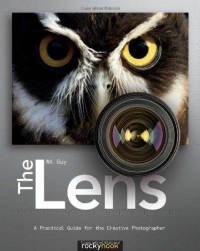Ahh… that’s the age old question for photographers, isn’t it. After all, photography is all about the glass. More than the camera or any other accessory you could buy, more than megapixels, the lens is the fundamental factor that controls both the technical quality and the creative, personal feel and style of your imagery.
This is why interchangeable lens systems have been at the heart of serious photography for decades, and why the question of which lens to buy is the most important purchase decision for any photographer to make.
That said, how much do you really know about lenses?
Photographer and writer NK Guy has just released a fantastic new book called The Lens: A Practical Guide for the Creative Photographer that takes a comprehensive look at lenses and how they work. The goal of this book is simple, it’s designed to teach you everything you ever wanted to know about lenses so that you can make educated buying decisions and choose the perfect collection of lenses to suit your style and needs.
When I say “everything you wanted to learn,” what I mean is “everything you every wanted to learn and more. Starting with history, NK details the science of light and explains the optical principles about how lenses work. He goes on to talk about refraction, why lenses use multiple elements, and how to understand the unique characteristics between different kinds of lenses, such as wide angles, telephotos, fisheyes, etc…
NK talks lens mounts, apertures, metering, depth of field, focus, autofocusing motors, image stabilization, electronics, zooms, primes, and how to understand all of the features, terms, different build qualities, formats, speeds and handling characteristics that are found on just about any type of lens.
And that’s just the first 78 pages. After three chapters of astounding technical detail, NK begins talking about how to actually use lenses. The next few chapters discuss choosing and using the right lens for a project, whether you’re shooting portraits, landscapes, kids, closeup, sports, travel and wildlife and using different focal lengths. This is where he delves into the creative aspects of photography and teaches you how to get the most out of each type of lens.
Next is accessories. Hoods, filters, extenders, teleconverters, closeup tools, focusing rails, tripod mounts, you name it. It’s all here.
Finally, in Chapter 7, NK starts talking about buying lenses and covers all of the factors that you need to consider before plunking down your hard earned change. He gives pros and cons for each type of lens, offers advice on where to buy. This is an interesting topic, because he goes into depth about the world of camera retail and offers some great advice.
Ok, we’re not quite done yet. If you didn’t get enough technical stuff in Chapters 1-3, you can work your way through Chapter 8, which covers advanced topics, such as distortion, digital correction, spherical abberation, lens flare, sharpness, bokeh, coatings, vignetting, hyperfocal distance, tilt and shift, aspheric lens elements, low dispersion glass, optical flaws, how lenses are actually made… the list goes on. Like I said, EVERYTHING you ever wanted to know about lens. AND MORE.
He ends by discussing further creative options and non-traditional equipment and techniques, such as using Lensbabies, pinhole cameras, homemade lenses, toy cameras, adapting lenses for other camera systems, manual focus, and of course, 5 appendices and a full glossary.
Whew!!! Seriously, The Lens: A Practical Guide for the Creative Photographer is one of the most fascinating photography books that I’ve ever read. It belongs on every photographer’s bookshelf or coffee table, because it’s the kind of book that has something for everyone. It offers everything from reference, to practical hints to a host of creative and technical tips and all the technical stuff to make you a complete lens expert.
Whether you use a DSRL, a mirrorless camera system, or a rangefinder, if you genuinely LOVE photography, then I would imagine that you’ll love NK’s book The Lens. Check it out. There’s even a Kindle verison and an enhanced iPad version, although for that you need iBooks 3 and iOS 6.
Note, NK Guy is also the author of the book Mastering Canon EOS Flash Photography, which is pretty much the Joe McNally style flash book for Canon users.
[iframe]<iframe src=”http:///e/cm?lt1=_blank&bc1=000000&IS2=1&bg1=FFFFFF&fc1=000000&lc1=0000FF&t=danhbaisadvph-20&o=1&p=8&l=as4&m=amazon&f=ifr&ref=ss_til&asins=1933952970″ style=”width:120px;height:240px;” scrolling=”no” marginwidth=”0″ marginheight=”0″ frameborder=”0″></iframe>[/iframe]

